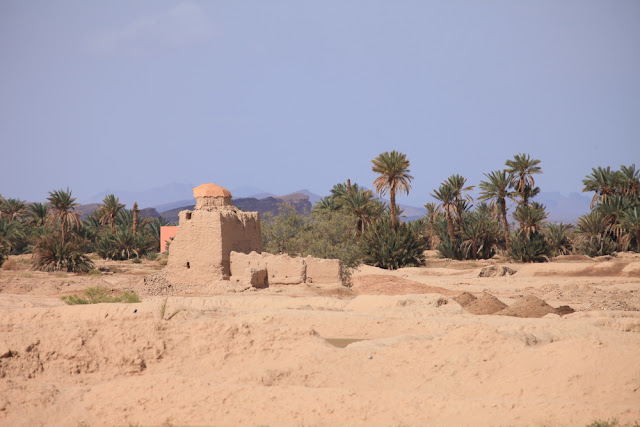Our explorations began with a morning tour of a fossil processing center, which is really just another one of the area's many fossil shops. Quarries are located all around this part of the country but Erfoud is the source area and economic center of the fossil industry. It sounds strange to say "fossil industry" but fossils are worth $40 million per year to the country (2009 data).
These fossils are known as Orthoceras (Orthoceras sp.) from the Latin for "straight horn." They are nautiloids related to modern day squid and octopus. This is a slab that has been horizontally cut and ready to be made into a large floor tile or coffee table.
This is a coiled nautilus known as an ammonite. It appeared to me that some soft body remains might be preserved at the opening of the shell. If so, this would be a spectacular example of very detailed preservation.
More ammonites. The fossils in this part of Morocco range in age from Cambrian to Devonian (about 550 to 360 million years).
Saudi Aramco Magazine ran this feature article on Morocco's trilobite economy.
In the American Southeast, we rarely find the calyx (head) of crinoids but in Morocco they are wonderfully preserved. These animals were attached to the sea floor and swayed back and forth with the currents. As food drifted by, the feathery tops filtered the food and ingested it downward. Crinoids are related to sea stars and sea urchins.
These are some of the best preserved trilobites I've ever seen. See this New York Times article about Erfoud's place in Morocco's fossil industry.
Next on to Rissani where I saw that the date crop is almost ready for picking. The dates are delicious.
Rissani is located at the junction of a north/south travel corridor and an east/west corridor. In ancient times it was a very important stop along the caravan routes from Mecca to the Maghreb. These are the ruins of a once thriving city near Rissani during the heyday of the camel caravans.
A colorful display located outside a shop in Rissani.
A vendor in Rissani.
The rain had been falling for a few weeks in the Sahara and the Atlas Mountains and we got to experience the desert during a very wet phase.
The rains also cleared away the typical Old World haze that seems to prevail all over Europe and North Africa. We had spectacular skies that seemed to stretch forever into the distance!
Ventifacts (rocks shaped by the long-term buffeting of blowing sand) were commonly seen on the desert floor.
A far-off rain squall creates shafts of sunlight in the Sahara.
These are views I am very familiar with in western North America - an isolated thunderstorm in the distance.
Finally, the Mergouza dunes came into view. These are located about 30 miles southeast of Erfoud.
Close-up of the dunes near sunset.
Note the ephemeral stream running at the base of the dunes. In the Old World, it his common to have trees growing in dune fields.
These dunes are very popular with travelers and many people spend the night in these tented compounds. Our group enjoyed an outdoor dinner in one such compound, complete with Bedouin music and a fantastic view of the Milky Way.
This was our camel driver who took us on the easiest, smoothest cameral ride I have ever enjoyed.
The sand was cool and moist to the touch having been protected by cloud most of the day.
Each grain of sand is composed of pure white quartz grains, eroded from granite or sandstone. Each grain has a thin coating of iron oxide on its surface to give it the red color.
What a romantic view! I thought of all the caravans that traversed the Sahara through the millennia.
For the real hearty geologists out there, be sure to check out a short geologic history of Morocco here taken from Deposits Magazine.

























No comments:
Post a Comment
If your comment will not post, email me with the problem.